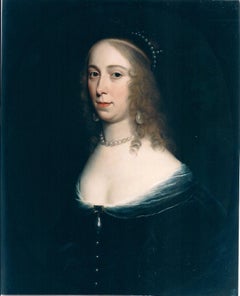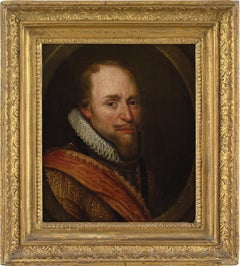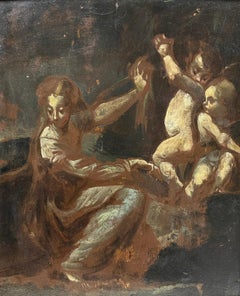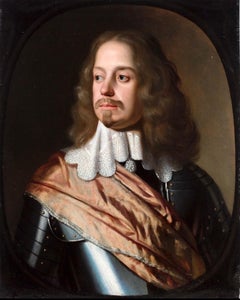Gerard van Honthorst Paintings
Dutch, 1592-1656
Gerard van Honthorst was a Dutch Golden Age painter who became known for his depiction of artificially lit scenes, eventually receiving the nickname Gherardo delle Notti. Early in his career he visited Rome, where he had great success painting in a style influenced by Caravaggio. Following his return to the Netherlands he became a leading portrait painter.(Biography provided by Shelton)
to
1
1
1
1
Overall Height
to
Overall Width
to
1
1
1
1
1
1
839
650
649
610
1
1
Artist: Gerard van Honthorst
The Pearl Lady, Oil on board signed Honthorst, dated 1644
By Gerard van Honthorst
Located in Paris, FR
The Pearl Lady, most probably Elisabeth of Bohem, Princess Palatine.
Oil on board signed Honthorst, dated 1644
Within a beautiful tortoise shell
With a certificate by René Millet ( Well Known French Expert in Paris)
The young unknown portrait shows the talent of the artist. We will appreciate the quality of glazed face, the light in the beads and the psychological analysis of the model. We almost read the character of the model. This type of face is found throughout the valley of the Rhin, Switzerland, the Netherlands.
Our beauty is flirtatious and love beautiful pearls, symbol of fidelity. And so the large barocco pearl, the earrings, the necklace, the adornment in her hair; all attest of the prosperity.
Gerrit Van Honthorst was born in 1590 and died 1656.
His career is divided into two very different parts.
In the first part of his life he is The “Night Master”, "Cavaragesque" painter, that the Italian nicknamed GUERARDO OF THE NOTTE. This period mainly Roman, which will influence LA TOUR and REMBRAND overshadowed the rest of his work.
Indeed, it has been forgotten today; but when GUERARDO DE LA NOTTE returned to Utrecht, he became a fashionable portrait's painter. Radical changes without knowing the real reasons although it is often forgotten that a painter like everyone needs to survive ... Especially since the death of Van Dyck has opened the road to our artist who will rush into exploiting it. He is called to the court of Charles I, in London, where he will paint the king and the nobles of the court. In 1637, he moved to The Hague and become Van Dyck's official successor for the Netherlands and all Europe.
Gerrit van Honthorst’s night paintings caused such a sensation in Rome that he was known as Gherardo delle Notti...
Category
17th Century Old Masters Gerard van Honthorst Paintings
Materials
Wood Panel
Related Items
Michiel Jansz. Van Mierevelt (Follower), Portrait of Maurice of Orange
Located in Cheltenham, GB
This early to mid-17th-century oil on panel depicts Maurice of Nassau (1567-1625), Prince of Orange. It’s a bust-length portrait, presented in a feigned oval, after a full length by ...
Category
Mid-17th Century Old Masters Gerard van Honthorst Paintings
Materials
Oil, Wood Panel
Angelic Cherubs with Classical Figure in Wilderness Finely Painted Preparatory
Located in Cirencester, Gloucestershire
Figure with Cherubim in Wilderness
Italian School, 17th century
oil painting on wood panel
framed 13 x 11 inches
condition: overall for its age very good, though the work is most likely a preparatory...
Category
17th Century Old Masters Gerard van Honthorst Paintings
Materials
Oil, Wood Panel
Italian 18th Century Oval Religious Oil on Canvas Painting with Saint Dominic
By Francesco de Mura
Located in Firenze, IT
This beautiful Italian 18th Century old masters oil painting on oval canvas with giltwood frame is attributed to Solimena and features a religious scene.
In this splendid oval-shaped painting are depicted Saint Dominic...
Category
18th Century Old Masters Gerard van Honthorst Paintings
Materials
Oil, Canvas
Man in Tavern Smoking a Pipe /// Old Masters Dutch David Teniers Portrait Face
By David Teniers the Younger
Located in Saint Augustine, FL
Artist: Unknown (Circle of David Teniers the Younger, Flemish, 1610-1690)
Title: "Man in Tavern Smoking a Pipe"
*No signature found
Circa: 1690
Medium: Original Oil Painting on Wooden Board
Framing: Framed in an antique gold gesso frame...
Category
1690s Old Masters Gerard van Honthorst Paintings
Materials
Gold Leaf
Large 17th Century Dutch Old Master Oil Painting on Wood Panel Biblical Scene
Located in Cirencester, Gloucestershire
Biblical Figures, Large Gathering around Christ?
Dutch Old Master, early 17th century
oil painting on wood panel, stuck on velvet backing board
velvet board: 27 x 29 inches
board: 25.5 x 26 inches
provenance: private collection, France
condition: good and sound condition, obvious old panel...
Category
Early 17th Century Old Masters Gerard van Honthorst Paintings
Materials
Wood Panel, Oil
Portrait of Gentleman, Thomas Bruce, Earl of Elgin c.1638 Manor House Provenance
Located in London, GB
Titan Fine Art present this picture which formed part of a historic collection of an English aristocratic family, Lord and Lady Sandys at their magnificent baroque and Regency Grade-...
Category
17th Century Old Masters Gerard van Honthorst Paintings
Materials
Oil, Wood Panel
H 18.9 in W 16.15 in D 1.58 in
Portrait Gentleman Black Coat Orange Sash, Dutch Old Master, Oil on Panel c.1650
By Bartholomeus van der Helst
Located in London, GB
This exquisite portrait of a gentleman depicted in a sumptuous black coat edged with silver and slashed sleeves is an excellent example of the type of portrait fashionable in England and the Low Countries during the 17th century. The confident pose, striking orange sash - the colour of the house of Orange Nassau - and the leather gorget imbue the sitter with a sense of masculinity and power. The profusely decorated costume is of the highest quality and de rigueur of an elite class - the artist has carefully cultivated this portrait to emphasise the sitter’s wealth and standing in the society that he belonged to. The casual pose, with one arm resting on a hip, is much less formal than earlier decades, and it speaks of ‘sprezzatura’ – one’s appearance should not appear laborious, but instead, effortless.
The oil on cradled panel portrait can be dated to circa 1650 based on the hairstyle and the attire - small falling collar, short doublet (doublets reduced in size to just below the ribcage in the late 1650’s), and the type of slashed sleeves with the sleeve seams left open to reveal the white fabric.
The demand for portraits in the Netherlands was great in the 17th century. Bartholemeus van der Helst was considered to be one of the leading portrait painters of the Dutch Golden Age surpassing even Rembrandt as the most sought-after portraitist in Harlaam. The Dutch Golden Age, roughly spanning the 17th century, was a period when Dutch trade, science, military, and art were among the most acclaimed in the world. Dutch explorers charted new territory and settled abroad. Trade by the Dutch East-India Company thrived, and war heroes from the naval battles were decorated and became national heroes. During this time, The Dutch Old Masters began to prevail in the art world, creating a depth of realistic portraits of people and life in the area that has hardly been surpassed. The Golden Age painters depicted the scenes that their discerning new middle-class patrons wanted to see. This new wealth from merchant activities and exploration combined with a lack of church patronage, shifted art subjects away from biblical genres. Still life’s of items of everyday objects, landscapes, and seascapes reflecting the naval and trade power that the Republic enjoyed were popular. The new wealthy class were keen to have their portraits commissioned and many artists worked in this lucrative field. Such was the popularity of art that everyone had a painting, even the humble butcher, and hundreds of thousands of paintings were produced.
By tradition the sitter is Maarten Tromp (1598-1653) who was an Admiral in the Dutch Navy (the reverse of the portrait contains an old handwritten inscription “van Tromp”). Certainly, the distinctive orange sash is similar to those worn by officers of the Dutch army in the Netherlands who served under the Princes of Orange and the House of Nassau. However, it should be noted that the physiognomy differs from other images of Tromp.
Tromp was the oldest son of Harpert Maertensz, a naval officer and captain. He joined the Dutch navy as a lieutenant in July 1622 and was later promoted from captain to Lieutenant-Admiral of Holland and West Frisia in 1637. In 1639, during the Dutch struggle for independence from Spain, Tromp defeated a large Spanish fleet bound for Flanders at the Battle of the Downs, which marked an enormous change - the end of Spanish naval power. He was killed in action during the First Anglo-Dutch War in 1653 where he commanded the Dutch fleet in the battle of Scheveningen.
Gloves were an absolutely vital accessory and the elaborate pair in this portrait are embellished with threads of silk and precious metals and salmon-coloured lining. He wears only one glove and holds the other, providing an opportunity to better display the cuffs and detail on his right wrist and forearm. The gloves are probably made from the most prized leather which came from Spain, in particular from Cordova. Cordovan leather was tanned with a special vegetal process that left it both highly impermeable and divinely soft. King Charles I, posed in a rather relaxed manner for Daniel Mytens’s portrait in 1631, is wearing gloves and boots in matching Cordovan leather. The hide is thick, but you can see just how supple it is from the way the gauntlet dimples and the long boot legs fold over themselves, rippling and wrinkling at the ankles.
Apart from keeping hands warm the use of gloves during the 15th through the 19th centuries were full of symbolism and they were worn regardless of the season. They kept the skin unblemished - soft, smooth hands were considered highly attractive. This combination of necessity and proximity to bare skin made gloves a deeply personal gift and they took on a strong symbolic significance and were regarded as emblematic of fidelity and loyalty for hundreds of years. Such was the importance of their symbolism was that some gloves were never intended to be worn at all. Their luxury made them ideal gifts at court, and so in the 15th and 16th centuries, ambassadors often presented them as symbols of loyalty.
Until the mid-19th century, it was customary to give gloves as tokens to guests at weddings and to mourners at funerals. Gentleman often gifted their bride-to-be with a pair of gloves (the obligatory gift) and were handed over at the betrothal and put on display before the wedding took place. It was probably their direct contact with the skin that led to the eroticism of gloves. Not only were pairs often exchanged between lovers, but from the 16th to the 18th centuries, it was common practice to remove one glove and give it as a gift to a favourite. The idea of the item being presented still warm from the wearer’s hand is certainly suggestive. Following the death of King George IV, his executors purportedly found over a thousand mismatched ladies’ gloves among his possessions.
The sentiment of a 17th-century poem reveals the popularity of the practice: “Come to our wedding to requite your loves / Shew us your hands and we’ll fit you with gloves.” Such generosity might be pricey for the hosts, but gloves of varying quality could be offered depending on the status of the recipient. Pairs made with the finest Spanish leather might be reserved for immediate family, while coarse sheep’s leather could be distributed among the servants and tradesmen. The apportioning of quality according to class provided a very clear message of the gloves’ intended use. For refined guests, they were decoration; for the lower classes, they were functional.
Bartholomeus van der Helst...
Category
17th Century Old Masters Gerard van Honthorst Paintings
Materials
Oil, Wood Panel
H 38.59 in W 31.89 in D 2.76 in
The Card Players by a Flemish 1600s Artist
By Flemish School, 17th Century
Located in Stockholm, SE
Flemish 1600s School
The Card Players
oil on oak panel
panel dimensions 22.5 x 20 cm
frame included
Provenance:
From a Swedish private collection.
Condition:
Flat and stabl...
Category
17th Century Old Masters Gerard van Honthorst Paintings
Materials
Oak, Oil, Panel
Two royal portraits (the Duc d'Angoulême and the Duc de Berry) by H.P. Danloux
Located in PARIS, FR
These two royal portraits are a major historical testimony to the stay of the Comte d'Artois (the future Charles X) and his family in Edinburgh in 1796-1797. Given by the sitters to Lord Adam Gordon, the Governor of Edinburgh, and kept by family descent to this day, these two portraits provide us with a vivid and spontaneous image of the Duc d’Angoulême and his brother the Duc de Berry. Danloux, who had emigrated to London a few years before, demonstrate his full assimilation of the art of British portrait painters in the brilliant execution of these portraits.
1. Henri-Pierre Danloux, a portraitist in the revolutionary turmoil
Born in Paris in 1753, Henri-Pierre Danloux was first a pupil of the painter Nicolas-Bernard Lépicié (1735 - 1784) and then, in 1773, of Joseph-Marie Vien (1716 - 1809), whom he followed to Rome when, at the end of 1775, Vien became Director of the Académie de France. In Rome he became friends with the painter Jacques-Louis David (1748 - 1825).
Returning to France around 1782, he settled in Lyon for a few years before returning to Paris in 1785. One of his first portraits was commissioned by the Baroness d'Etigny, the widow of the former Intendant of the Provinces of Gascony, Bearn and Navarre Antoine Mégret d'Etigny (1719 – 1767). He then became close to his two sons, Mégret de Sérilly and Mégret d'Etigny, who in turn became his patrons. In 1787, this close relationship with the d'Etigny family was further strengthened by his marriage to Antoinette de Saint-Redan, a relative of Madame d'Etigny. After his marriage, he left for Rome and did not return to France until 1789. It was during the winter of 1790-1791 that he painted one of his masterpieces, the portrait of Baron de Besenval. Set in a twilight atmosphere, this portrait of an aristocrat who knows that his death is imminent symbolizes the disappearance of an erudite and refined society which would be swept away by the French Revolution.
The Jacobin excesses led Danloux to emigrate to England in 1792; many members of his family-in-law who remained in France were guillotined on 10 May 1794. Danloux enjoyed great success as a portrait painter in England before returning to France in 1801.
During his stay in England, Danloux was deeply under the influence of English portraitists: his colors became warmer (as shown by the portrait of the Duc d'Angoulême that we are presenting), and his execution broader.
2. Description of the two portraits and biographical details of the sitters
The Duc d'Angoulême (1775-1844) was the eldest son of the Comte d'Artois, the younger brother of King Louis XVI (the future King Charles X), and his wife Marie-Thérèse of Savoie. He is shown here, in the freshness of his youth, wearing the uniform of colonel-general of the "Angoulême-Dragons" regiment.
He is wearing the blue cordon of the Order of the Holy Spirit, which was awarded to him in 1787, and two decorations: the Cross of Saint-Louis and the Maltese Cross, as he was also Grand Prior of the Order of Malta.
Born on 16 August 1775 in Versailles, Louis-Antoine d'Artois followed his parents into emigration on 16 July 1789. In 1792, he joined the émigrés’ army led by the Prince de Condé. After his stay in Edinburgh (which will be further discussed), he went to the court of the future King Louis XVIII, who was in exile at the time, and in 1799 married his first cousin Marie-Thérèse Charlotte of France, the daughter of Louis XVI and the sole survivor of the royal family. The couple had no descendants. He became Dauphin of France in 1824, upon the accession to the throne of his father but played only a minor political role, preferring his military position as Grand Admiral. Enlisted in Spain on the side of Ferdinand VII, he returned home crowned with glory after his victory at Trocadero in 1823.
He reigned for a very short time at the abdication of Charles X in 1830, before relinquishing his rights in favor of his nephew Henri d'Artois, the Duc de Bordeaux. He then followed his father into exile and died on 3 June 1844 in Gorizia (now in Italy).
His younger brother, the Duc de Berry, is shown in the uniform of the noble cavalry of the émigrés’ Army. He is wearing the blue cordon of the Order of the Holy Spirit, awarded to him in May 1789, and the Cross of Saint-Louis (partly hidden by his blue cordon).
Born on 24 January 1778 in Versailles, Charles-Ferdinand d'Artois also followed his parents into emigration and joined the émigrés’ army in 1792. After his stay in Edinburgh, he remained in Great Britain, where he had an affair with Amy Brown...
Category
1790s Old Masters Gerard van Honthorst Paintings
Materials
Canvas, Oil, Wood Panel
Portrait of three children - Bernhard Keil (1624-1687)
Located in Gent, BE
“A portrait of three children, one of them holding a basket of grapes, while another plays the flute”
Oil on canvas
Housed in a blackened 17th-century frame.
We'd like to thank dr...
Category
17th Century Old Masters Gerard van Honthorst Paintings
Materials
Oil, Panel
Portrait of a Lady Diana Cecil, Countess of Elgin c.1638, Manor House Provenance
Located in London, GB
Titan Fine Art present this picture which formed part of a historic collection of an English aristocratic family, Lord and Lady Sandys at their magnificent baroque and Regency Grade-...
Category
17th Century Old Masters Gerard van Honthorst Paintings
Materials
Oil, Wood Panel
H 18.9 in W 16.15 in D 1.58 in
Portrait of a Young Man - 17th Century Portrait in Oil
By Pieter Harmensz Verelst
Located in London, GB
Circle of Pieter Harmensz Verelst
1618 - 1678
Portrait of a Young Man
Oil on oak panel
Image size: 7 ½ x 5 ¾ inches
Dutch ripple frame
Category
18th Century and Earlier Old Masters Gerard van Honthorst Paintings
Materials
Panel, Oil
Previously Available Items
Portrait of Jacob van Wassenaer Obdam 1610 - 1665
By Gerard van Honthorst
Located in LA BOUILLE, FR
Portrait of Jacob van Wassenaer Obdam 1610 - 1665 by Gerrit Van Honthorst 1592-165
Like many Dutch people of his time, the young Gerrit van Honthorst left for Rome to train. He remained there for ten years, protected by the greatest: the Marquis of Giustiniani (1564-1637), with whom he would meet Guido Reni (1575-1642), the Grand Duke of Tuscany, and Cardinal Scipione Borghese (1576-1633) himself. His return to Utrecht marked the most famous period of his career: he became, together with Hendrick ter Brugghen (1588-1629) and Dirck van Baburen...
Category
17th Century Baroque Gerard van Honthorst Paintings
Materials
Oil, Wood Panel
H 29.1 in W 22.84 in D 0.79 in
Gerard Van Honthorst paintings for sale on 1stDibs.
Find a wide variety of authentic Gerard van Honthorst paintings available for sale on 1stDibs. You can also browse by medium to find art by Gerard van Honthorst in panel, wood panel and more. Much of the original work by this artist or collective was created during the 18th century and earlier and is mostly associated with the Old Masters style. Not every interior allows for large Gerard van Honthorst paintings, so small editions measuring 24 inches across are available. Customers who are interested in this artist might also find the work of Studio of Sir Peter Lely, Sir Godfrey Kneller, and Matthew Cook. Gerard van Honthorst paintings prices can differ depending upon medium, time period and other attributes. On 1stDibs, the price for these items starts at $178,743 and tops out at $178,743, while the average work can sell for $178,743.



